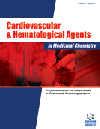- Home
- A-Z Publications
- Cardiovascular & Hematological Agents in Medicinal Chemistry (Formerly Current Medicinal Chemistry - Cardiovascular & Hematological Agents)
- Previous Issues
- Volume 5, Issue 1, 2007
Cardiovascular & Hematological Agents in Medicinal Chemistry (Formerly Current Medicinal Chemistry - Cardiovascular & Hematological Agents) - Volume 5, Issue 1, 2007
Volume 5, Issue 1, 2007
-
-
Putative Role for Apelin in Pressure/Volume Homeostasis and Cardiovascular Disease
More LessApelin is a peptide recently isolated from bovine stomach extracts which appears to act as an endogenous ligand for the previously orphaned G-protein-coupled APJ receptor. The apelin gene encodes for a pre-propeptide consisting of 77 amino acids with mature apelin likely to be derived from the C-terminal region as either a 36, 17 or 13 amino acid peptide. Apelin mRNA expression and peptide immunoreactivity has been Read More
-
-
-
Computer Prediction of Cardiovascular and Hematological Agents by Statistical Learning Methods
More LessComputational methods have been explored for predicting agents that produce therapeutic or adverse effects in cardiovascular and hematological systems. The quantitative structure-activity relationship (QSAR) method is the first statistical learning methods successfully used for predicting various classes of cardiovascular and hematological agents. In recent years, more sophisticated statistical learning methods have been Read More
-
-
-
The Role of the Thrombospondins in Healing Myocardial Infarcts
More LessAuthors: Khaled Chatila, Guofeng Ren, Ying Xia, Peter Huebener, Marcin Bujak and Nikolaos G. FrangogiannisThe five current members of the thrombospondin (TSP) family can be divided in two subgroups according to their molecular architecture. TSP-1 and -2 (subgroup A) are trimeric matricellular proteins that do not contribute directly to tissue integrity, but influence cell function by modulating cell-matrix interactions, whereas TSP-3, -4 and -5 (subgroup B) are pentameric proteins. TSP-1 and TSP-2 are markedly induced in heali Read More
-
-
-
Structure-Activity Relationship Studies on ADAM Protein-Integrin Interactions
More LessAuthors: X. Lu, D. Lu, M. F. Scully and V. V. KakkarThe ADAM (a disintegrin and metalloprotease) family of proteins possess multi-domain structures composed of a signal peptide, a prodomain, a metalloprotease domain, a disintegrin-like domain, a cysteine rich domain, an epidermal growth factor-like domain, a transmembrane domain and cytoplasmic tail. The disintegrin-like domain shares sequence similarity with the soluble venom disintegrins, a family of proteins which ar Read More
-
-
-
Glibenclamide Action on Myocardial Function and Arrhythmia Incidence in the Healthy and Diabetic Heart
More LessAuthors: J. A. Negroni, E. C. Lascano and H. F. del ValleMyocardial sarcolemmal ATP-dependent potassium (KATP) channels, which are normally closed by high ATP concentration, open during ischemia when ATP generation decreases favoring K+ efflux. This reduces action potential duration (APD) decreasing the time of Ca2+ influx and Ca2+ overload. This behavior suggested that they might be involved in the protection against stunning and arrhythmias and in the mechanism Read More
-
-
-
HDL Elevators and Mimetics - Emerging Therapies for Atherosclerosis
More LessAuthors: Manojit Pal and Sivaram PillarisettiHigh plasma levels of LDL cholesterol, triglycerides and low levels of HDL cholesterol are strong and independent risk factors of coronary heart disease (CHD). The first two abnormalities are addressed by a variety of drugs including statins, cholesterol absorption inhibitors, fibrates and niacin. Some of these drugs also elevate HDL albeit weakly. Thus treatments optimized for HDL elevation are still an unmet medical nee Read More
-
-
-
Neoangiogenesis Induced by Progenitor Endothelial Cells: Effect of Fucoidan from Marine Algae
More LessAuthors: C. Boisson-Vidal, F. Zemani, G. Caligiuri, I. Galy-Fauroux, S. Colliec-Jouault, D. Helley and A.-M. FischerFucoidans -- sulphated polysaccharides extracted from brown algae - could be beneficial in patients with ischemic diseases. Their antithrombotic and proangiogenic properties promote in animals, neovascularization and angiogenesis which prevent necrosis of ischemic tissue. In 1997, endothelial progenitor cells were first identified in human peripheral blood. They are recruited from bone marrow and contribute to neo Read More
-
-
-
Cardiac ATP-Sensitive Potassium Channels: A Potential Target for an Anti-Ischaemic Pharmacological Strategy
More LessAuthors: L. Testai, S. Rapposelli and V. CalderoneBrief periods of ischaemia induce in the myocardium an increased resistance to the injury due to a subsequent, more prolonged ischaemic episode. This phenomenon, known as ischaemic pre-conditioning (IPC), articulated in two distinct phases (an early and a delayed one), is ensured by different biological mechanisms. Although an exhaustive comprehension of these mechanisms has not yet been reached, it is widely acc Read More
-
-
-
The Therapeutic Potential of PhospholipaseA2 Inhibitors in Cardiovascular Disease
More LessAuthors: M. C. White and J. McHowatLeukocyte recruitment and the expression of pro-inflammatory cytokines are prevalent characteristics of early atherogenesis [1]. Recently, several inflammatory mediators have been linked to atheroma formation and inflammatory pathways have been shown to promote thrombosis [1]. The discovery of mast cells, activated T lymphocytes and macrophages in atherosclerotic lesions, the detection of human leukocyte antigen Read More
-
Volumes & issues
-
Volume 23 (2025)
-
Volume 22 (2024)
-
Volume 21 (2023)
-
Volume 20 (2022)
-
Volume 19 (2021)
-
Volume 18 (2020)
-
Volume 2 (2020)
-
Volume 17 (2019)
-
Volume 16 (2018)
-
Volume 15 (2017)
-
Volume 14 (2016)
-
Volume 13 (2015)
-
Volume 12 (2014)
-
Volume 11 (2013)
-
Volume 10 (2012)
-
Volume 9 (2011)
-
Volume 8 (2010)
-
Volume 7 (2009)
-
Volume 6 (2008)
-
Volume 5 (2007)
-
Volume 4 (2006)
Most Read This Month
Article
content/journals/chamc
Journal
10
5
false
en


